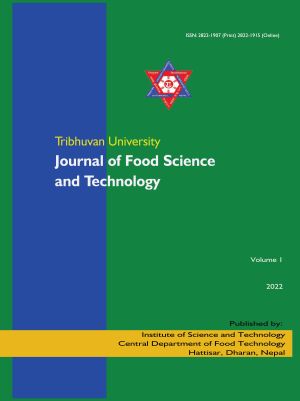Effect of Processing Methods on Bioactive Components and Antioxidant Activity of Beetroot (Beta vulgaris L.)
DOI:
https://doi.org/10.3126/tujfst.v1i1.49937Keywords:
Bioactive, Antioxidant activity, Betalain, Betaxanthin, Betacyanin, Total phenolAbstract
Beetroot (Beta vulgaris L.) is known as antioxidant, anti-inflammatory, hepato-protective and anticancer due to its bioactive components. The effect of processing (blanching, open pan cooking, pressure cooking, microwave oven treatment, electric oven treatment and drying) on the bioactive components (total phenolic and total betalain content) and antioxidant activity in beetroot were studied. The total betalain content (676.03 mg/100g db) included betacyanin (445.64 mg/100g db) and betaxanthin (230.39 mg/100g db). Total phenolic content, total betalain content and antioxidant activity were significantly different (p<0.05) in open pan cooked, pressure cooked and electric oven treated sample. The drying process significantly (p<0.05) decreased total phenolic and total betalain in blanched, open pan cooked, pressure cooked and electric oven treated samples. Betaxanthin was found more susceptible to heat than betacyanin. The antioxidant activity significantly (p<0.05) increased during drying of the pretreated samples. Microwave oven treatment was found to be suitable for pretreatment as it increases antioxidant activity, maximum retention in total phenolic content and betalain.
Downloads
Downloads
Published
How to Cite
Issue
Section
License
Copyright (c) 2022 Central Department of Food Technology (CDFT), Tribhuvan University

This work is licensed under a Creative Commons Attribution-NonCommercial 4.0 International License.
This license allows reusers to distribute, remix, adapt, and build upon the material in any medium or format for noncommercial purposes only, and only so long as attribution is given to the creator.




